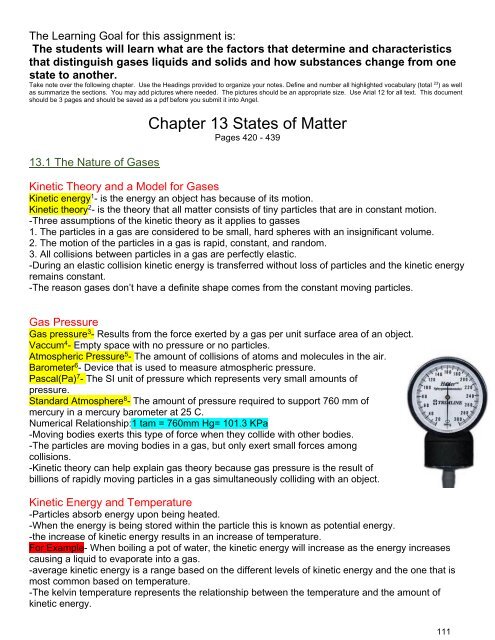Create successful ePaper yourself
Turn your PDF publications into a flip-book with our unique Google optimized e-Paper software.
The Learning Goal for this assignment is:<br />
The students will learn what are the factors that determine and characteristics<br />
that distinguish gases liquids and solids and how substances change from one<br />
state to another.<br />
Take note over the following chapter. Use the Headings provided to organize your notes. Define and number all highlighted vocabulary (total 23 ) as well<br />
as summarize the sections. You may add pictures where needed. The pictures should be an appropriate size. Use Arial 12 for all text. This document<br />
should be 3 pages and should be saved as a pdf before you submit it into Angel.<br />
13.1 The Nature of Gases<br />
Chapter 13 States of Matter<br />
Pages 420 - 439<br />
Kinetic Theory and a Model for Gases<br />
Kinetic energy 1 - is the energy an object has because of its motion.<br />
Kinetic theory 2 - is the theory that all matter consists of tiny particles that are in constant motion.<br />
-Three assumptions of the kinetic theory as it applies to gasses<br />
1. The particles in a gas are considered to be small, hard spheres with an insignificant volume.<br />
2. The motion of the particles in a gas is rapid, constant, and random.<br />
3. All collisions between particles in a gas are perfectly elastic.<br />
-During an elastic collision kinetic energy is transferred without loss of particles and the kinetic energy<br />
remains constant.<br />
-The reason gases don’t have a definite shape comes from the constant moving particles.<br />
Gas Pressure<br />
Gas pressure 3 - Results from the force exerted by a gas per unit surface area of an object.<br />
Vaccum 4 - Empty space with no pressure or no particles.<br />
Atmospheric Pressure 5 - The amount of collisions of atoms and molecules in the air.<br />
Barometer 6 - Device that is used to measure atmospheric pressure.<br />
Pascal(Pa) 7 - The SI unit of pressure which represents very small amounts of<br />
pressure.<br />
Standard Atmosphere 8 - The amount of pressure required to support 760 mm of<br />
mercury in a mercury barometer at 25 C.<br />
Numerical Relationship:1 tam = 760mm Hg= 101.3 KPa<br />
-Moving bodies exerts this type of force when they collide with other bodies.<br />
-The particles are moving bodies in a gas, but only exert small forces among<br />
collisions.<br />
-Kinetic theory can help explain gas theory because gas pressure is the result of<br />
billions of rapidly moving particles in a gas simultaneously colliding with an object.<br />
Kinetic Energy and Temperature<br />
-Particles absorb energy upon being heated.<br />
-When the energy is being stored within the particle this is known as potential energy.<br />
-the increase of kinetic energy results in an increase of temperature.<br />
For Example- When boiling a pot of water, the kinetic energy will increase as the energy increases<br />
causing a liquid to evaporate into a gas.<br />
-average kinetic energy is a range based on the different levels of kinetic energy and the one that is<br />
most common based on temperature.<br />
-The kelvin temperature represents the relationship between the temperature and the amount of<br />
kinetic energy.<br />
111



